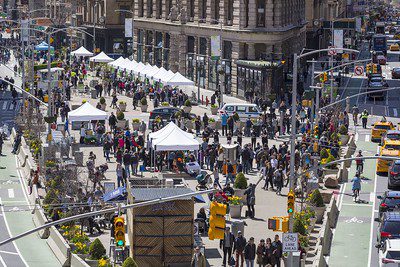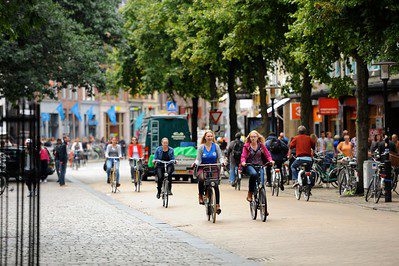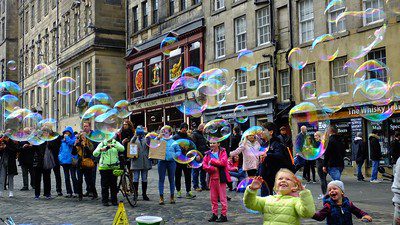In France it’s an annual event where thousands of Parisians flood the Champs-Élysées, while in Mumbai, residents are encouraged to leave their cars at home and cycle instead.
September 22 is world car free day. It’s an event where city streets are blocked to cars and opened up to people, a day highlighting sustainable transport options like walking, cycling and public transport.

The message is timely. While the broader shift from petrol and diesel to electric cars is an important step in tackling climate change, experts say more needs to be done, such as reducing the number of car trips overall and encouraging more sustainable modes of travel.
The Driven is not aware of any #carfreeday events happening in Australia this year. But many advocates wish that there were.
“The idea of car free day is that it gives citizens a glimpse of what their streets could look like, feel like, and how they function with less cars on the road,” Elliot Fishman, the director of the Institute for Sensible Transport, told The Driven.
Australian cities haven’t seen the large-scale car-free events held in other parts of the world, and one reason, Fishman suspects, is that Australian politicians and policy makers have been hesitant to challenge the status quo when it comes to transport, road building and the allocation of space in cities.
The problem with this approach is “that leaves us exactly where we are today”, with congestion getting worse. “Instead of having two lanes of congested traffic, you have four lanes”, he said.
Fishman runs study tours to Groningen, a city in the Netherlands widely regarded as an international success story for its car free streets.

While Groningen’s streets are now a “convivial space where children can play soccer” this wasn’t always the case.
In the early 1970s, a young, progressive council decided cars would no longer go through the town centre. They blocked the roads with boulders and gave out flowers to motorists, ”because it’s very hard to get angry with someone if they’re giving you a flower”, he said.
There are few recent examples of streets and highways being returned to pedestrians here in Australia. But Fishman said there are some positive signs, such as NSW transport minister Andrew Constance allocating $710 million for walking and cycling infrastructure.
Helen Rowe welcomes the growing interest from state and local governments in sustainable transport. “It’s great to see electric bus commitments, safer bike lanes rolling out across cities, and commitments to power our public transport with renewable energy”, she said.
Rowe leads ClimateWorks Australia’s transport team. She said that cutting transport emissions requires a suite of measures, including reducing car use because “if you just focus on electric vehicles and emissions, then you’re going to end up with gridlock”.
While the Australian discussion around transport emissions had been largely “framed around EVs, in other countries that’s not the case”. For example, walking and cycling is the first action area for Britain’s decarbonising transport strategy.
Rowe added, while not completely car free, ideas like congestion charging could encourage less driving, while also potentially raising funds to improve walking, cycling and public transport infrastructure.
“There’s all sorts of ways that we can redesign our suburbs to make it easier to walk around”, according to Duane Burtt, principal policy advisor at Victoria Walks, listing pedestrian crossings, lower speed limits, curb extensions and median strips.
“I think there’s increasing recognition from governments and government agencies that walking is a solution for transport and for the climate crisis”, he said.
An example, he said, is the Victorian Government’s target to have 25% of transport trips by active transport in 2030 as part of its climate change strategy.
Some local governments, like Moreland City Council, have made a start by closing streets outside of schools, Burtt said, but he would welcome more measures to free up streets for “walking, riding, playing, public art, like they have overseas”.
Transport pollution is primarily a social justice issue, according to Laura Sykes, sustainable cities coordinator at Friends of the Earth Melbourne.
“Accessible transport solutions are essential for many people who may not be able to drive due to disability or age”, she said.
“Our transport sector must move away from being car dependent to heavily investing in public and active transport infrastructure that reduces emissions, improves health outcomes and connects our communities.”
Jago Dodson, a professor of urban policy at RMIT said, “many cities around the world provide a high level of mobility to urban residents without relying on private automobiles”.
“For climate mitigation we should be encouraging much more walking as that is the only truly sustainable travel mode. For shorter local trips cycling is a good option, particularly (renewable) electric cargo bikes for shopping trips.”
For metropolitan and regional scale travel, Dodson said, high quality public transport networks with services running at five minute frequency – or better – are essential to allow urban residents to leave their car at home.
He added, “we need to add green space to our cities to adapt to climate impacts, so converting road space to parks and biodiversity habitat offers a major opportunity”.
With more support for public transport, walking and cycling, and initiatives to return streets to people, car free days could even become a regular event.

Petra Stock is a Master of Journalism student who has worked in climate change, renewable energy and transport. She also works part-time in climate change for the Australian Conservation Foundation.

